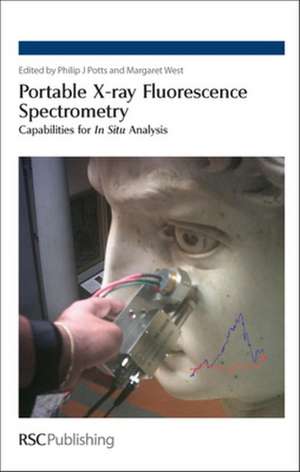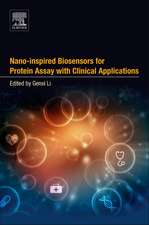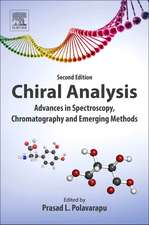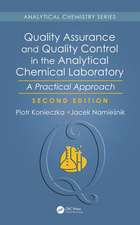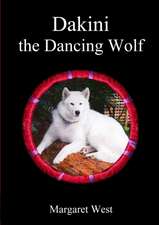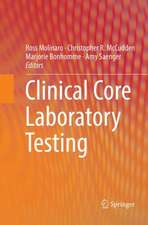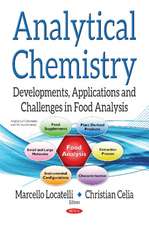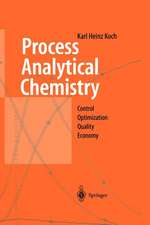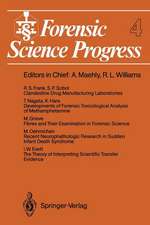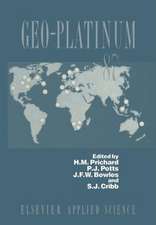Portable X-Ray Fluorescence Spectrometry
Editat de Philip J. Potts, MARGARET WESTen Limba Engleză Hardback – 30 iun 2008
Portable X-ray fluorescence (PXRF) instrumentation has some unique analytical capabilities for the in situ analysis of samples in the field. These capabilities have been extended in recent years by the continuing development of solid state detectors, surface mounted electronics, digital signal processing technology, Li-ion batteries combined with a choice of rugged sealed radioisotope sources or miniature X-ray tubes that provide lightweight hand-held devices. As well as opening up new applications, in situ measurements by PXRF, where the instrument is placed in direct contact with the object to be analysed, involve the complete integration of sampling and analysis. Careful interpretation of results is therefore required, particularly when the analysis is used to estimate the bulk composition of a sample. In this monograph, an overview is given of instrumentation, analytical capabilities, and limitations in the interpretation of results, sampling considerations and applications where PXRF offers substantial advantages over conventional analytical techniques. The aim is to give the reader an insight into the capabilities of the technique and to demonstrate the contribution it can make to a range of areas of contemporary scientific interest. Chapters are written by internationally recognised scientists with practical experience of in situ analysis using portable X-ray fluorescence and demonstrates the wide range of applications for the technique. The topics covered are illustrated with diagrams and photographs where appropriate and each chapter includes supporting references to enable the reader to gain a greater understanding of a particular application. Topics include: -analytical capabilities -instrumentation -quantification -correction procedures -sampling considerations -future developments Applications include: -the assessment of contaminated land -surfaces -coatings and paints -workplace monitoring -metal & alloy sorting -geochemical prospecting -archaeological investigations -museum samples & works of art -extraterrestrial analysis The work is aimed at scientists who have some knowledge of analytical techniques and/or the applications covered, but are not fully familiar with the capabilities of PXRF. It offers a general introduction to the technique and its applications rather than a research monograph. As such, it is aimed at analytical scientists, environmental and geological scientists, industrial hygienists, industrial and plant scientists, archaeometrists and museum researchers, research scientists and research students with projects in the applications covered. Undergraduate students studying associated degree courses will also benefit from the work.
Preț: 949.20 lei
Preț vechi: 1103.72 lei
-14% Nou
Puncte Express: 1424
Preț estimativ în valută:
181.65€ • 188.95$ • 149.96£
181.65€ • 188.95$ • 149.96£
Carte tipărită la comandă
Livrare economică 15-29 aprilie
Preluare comenzi: 021 569.72.76
Specificații
ISBN-13: 9780854045525
ISBN-10: 085404552X
Pagini: 291
Ilustrații: 30 black & white illustrations, 62 colour illustrations
Dimensiuni: 155 x 236 x 23 mm
Greutate: 0.61 kg
Editura: Royal Society Of Chemistry
ISBN-10: 085404552X
Pagini: 291
Ilustrații: 30 black & white illustrations, 62 colour illustrations
Dimensiuni: 155 x 236 x 23 mm
Greutate: 0.61 kg
Editura: Royal Society Of Chemistry
Cuprins
Chapter 1: Introduction, analytical instrumentation and application overview; Chapter 2: Quantification and correction procedures; Chapter 3: Contaminated land: sampling considerations; Chapter 4: Surfaces, coatings and paint; Chapter 5: Hazardous Substances in the Workplace; Chapter 6: Metal and alloy sorting; Chapter 7: Geochemical prospecting; Chapter 8: Archaeological lithic provenancing; Chapter 9: Museum samples and works of art; Chapter 10: Extraterrestrial Analysis : Planetary X-ray Fluorescence from Orbiting Spacecraft and Landers
Notă biografică
Philip J Potts, Fellow of the Royal Society of Chemistry, is an analytical and chartered chemist with research interests in the development and application of techniques for the chemical analysis of geological and environmental samples. He has contributed to the analytical characterisation of the Beagle 2 XRF spectrometer; the development and application of portable XRF techniques to the characterisation of environmental (e.g. Pb in soil) and archaeological samples; the effect of weathering and surface roughness on PXRF quantification; the analytical data quality and proficiency testing and protocols for the characterisation of geological certified reference materials. He is also a Member of the Mineralogical Society, the Association of Exploration Geochemists, Association of University Radiation Protection Officers; President of the International Association of Geoanalysts, member of Executive Committee of Atomic Spectroscopy Updates (Journal of Analytical Atomic Spectroscopy), Member of the Instrumental Criteria Sub-committee (RSC) and Chair of Atomic Spectroscopy Group of the Royal Society of Chemistry. Margaret West is also an analytical chemist with experience in industrial and academic applications of X-ray spectrometry especially in manufacturing and associated raw materials industries. Recognised internationally for the development, application and training of X-ray analytical techniques she is also a Fellow of the Society of Glass Technology. She serves on national and international bodies responsible for the generation of certified reference materials and standard test methods for glass and other materials and is a Member of the Executive Committee of Atomic Spectroscopy Updates (Journal of Analytical Atomic Spectroscopy) and a Member of the Instrumental Criteria Sub-committee (RSC).
Textul de pe ultima copertă
Portable X-ray fluorescence (PXRF) instrumentation has some unique analytical capabilities for the in situ analysis of samples in the field. In this monograph, an overview is given of instrumentation, analytical capabilities, and limitations in the interpretation of results, sampling considerations and applications where PXRF offers substantial advantages over conventional analytical techniques. The aim is to give the reader an insight into the capabilities of the technique and to demonstrate the contribution it can make to a range of areas of contemporary scientific interest. Chapters are written by internationally recognised scientists with practical experience of in situ analysis using portable X-ray fluorescence. Portable X-ray Fluorescence Spectrometry: Capabilities for In Situ Analysis demonstrates the wide range of applications for the technique. Whilst many authors use commercially available instrumentation, applications such as the analysis of museum samples & works of art and extraterrestrial analysis demonstrate the ingenuity of the authors to develop and build equipment for specific studies. Sampling, quantification and correction procedures are presented to give the reader a comprehensive introduction to the capabilities of PXRF for in situ analysis. The book will be of interest to analytical scientists, environmental and geological scientists, industrial hygienists, industrial and plant scientists, archaeometrists and museum researchers, research scientists and students.
Descriere
This book brings together the knowledge and expertise of internationally recognised scientists with practical experience of in situ analysis using portable X-ray fluorescence technology.
